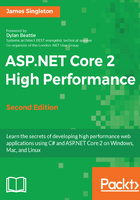
The new .NET
The new ASP.NET and the .NET Framework that it relies upon were rewritten to be open source and cross-platform in Core version 1. The packages were also split up, which although done with admirable intentions has caused confusion. ASP.NET Core 2 is now included in the .NET Core 2 installation package along with Entity Framework Core. This means that you no longer need to ship the ASP.NET Core framework with your app when you deploy. The project known as .NET Native has been postponed (outside of UWP) and will hopefully arrive within the next year.
All these different names can be perplexing, but naming things is hard. A humorous variation of Phil Karlton's famous quote goes like this:
We've looked at naming here, and we'll get to caching later on in this book.
It can be a little confusing understanding how all of these versions fit together. This is best explained with a diagram like the following, which shows how the layers interact:

ASP.NET Core 2 can run against the existing .NET Framework 4.7 or the new .NET Core 2 framework. Similarly, .NET Core can run on Windows, OS X / macOS, and Linux, but the old .NET only runs on Windows.
There is also the Mono framework, which has been omitted for clarity. This was a previous project that allowed .NET to run on multiple platforms. Mono was acquired by Microsoft, and it was open sourced (along with other Xamarin products). We are now starting to see the convergence of these different platforms, driven by the .NET Standard.
Core is not as feature filled as the existing .NET Framework, although the gap has shrunk significantly in version 2. If you write graphical desktop applications, perhaps using Windows Presentation Foundation (WPF), then you should stick with .NET 4. There is no plan to port these Windows-specific APIs to Core as then it wouldn't be cross-platform.
As this book is mainly about web-application development, we will use the latest Core versions of all the software. We will investigate the performance implications of various operating systems and architectures. This is particularly important if your deployment target is a computer, such as the Raspberry Pi, which uses a processor with an ARM architecture. It also has limited memory, which is important to consider when using a managed runtime that includes a garbage collection, such as .NET.